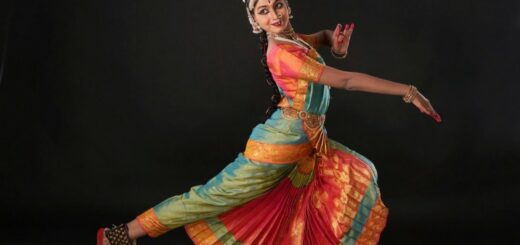Art & Culture: Miniature Painting Part II
The Central Indian And Rajasthani Schools (17th-19th Centuries)

- Unlike Mughal painting which is primarily secular, the art of painting in Central India, Rajasthani and the Pahari region etc. is deeply rooted in the Indian traditions, taking inspiration from Indian epics, religious texts like the Puranas, love poems in Sanskrit and other Indian languages, Indian folk-lore and works on musical themes.
- The cults of Vaishnavism, Saivism and Sakti exercised tremendous influence on the pictorial art of these places. Among these the cult of Krishna was the most popular one which inspired the patrons and artists.
- The themes from the Ramayana., the Mahabharata, the Bhagavata, the Siva Purana, the Naishadacarita, the Usha Aniruddha, the GitaGovinda of Jayadeva, the Rasamanjari of Bhanudatta, the Amaru Sataka, the Rasikapriya of Kesavadasa, the Bihari Satasayee and the Ragamala etc., provided a very rich field to the painter who with his artistic skill and devotion made a significant contribution to the development of Indian painting.
- In the 16th century there already existed in Central India and Rajasthan the primitive art traditions in the form of the ‘Western Indian’ and the ‘Chaurapanchasika’ styles which served as a base for the origin and growth of various schools of painting during the 17th century.
- Peaceful conditions prevailed in Rajasthan in the later half of the 16th and the 17th centuries.
- The Rajput rulers had gradually accepted the Mughal supremacy and many among them occupied important positions in the Mughal court. Some of the rulers also entered into matrimonial alliances with the Mughals.
- The Rajput rulers following the example set by the Mughal Emperors employed artists to work at their courts.
- It is believed that the popular version of the Mughal style which these painters carried to various places influenced the already existing styles of paintings there with the consequence that a number of new schools of painting originated in Rajasthan and Central India in the 17th and 18th centuries.
- Among these the important schools of paintings are Malwa, Mewar, Bundi- Kotah, AmberJaipur, Bikaner, Marwar and Kishengarh.
- The Rajasthani style of painting including that of Malwa, is marked by bold drawing, strong and contrasting colours. The treatment of figures is flat without any attempt to show perspective in a naturalistic manner. Sometimes the surface of the painting is divided into several compartments of different colours in order to separate one scene from another.
- Mughal influence is seen in the refining of drawing and some element of naturalism introduced in figures and trees. Each school of painting has its distinct facial type, costume, landscape and colour scheme.
Malwa:
- Some of the important paintings executed in the Malwa style are a series of the Rasikapriya dated 1634 A.D., a series of the Amaru Sataka painted in 1652 A.D. at a place called Nasratgarh and a series of the Ragamala painted in 1680 A.D. by an artist named Madhau Das, at Narsyanga Shah, some of them available in the National Museum, New Delhi, another Amaru-Sataka of the same period in the Prince of Wales Museum, Bombay and a Ragamala series of about 1650 A.D. in the Bharat Kala Bhavan, Banaras. The art of painting in Malwa continued till the end of the 17th century A.D.
- An example from a series of the Ragamala of 1680 A.D. represents the Megha Raga. The miniature shows the blue-complexioned Raga dancing with a lady to the accompaniment of music played by three female musicians.
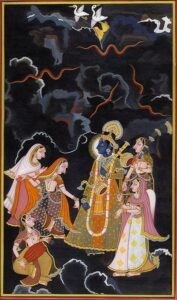
- The scene is laid against a blue background. The sky is overcast with dark clouds with a streak of lightening and rain is indicated by white dotted lines. Four swans flying in a row, against a dark background of clouds, enhance the pictorial effect to the miniature.
- The text is written in Nagari on the top. The typical characteristics of the painting are the use of contrasting colours, refinement of drawing due to the influence of the Mughal painting and ornaments and costumes consisting of black tassels and striped skirts.
Mewar:

- The earliest example of Mewar painting is a series of the Ragamala painted in 1605 A.D. at Chawand, a small place near Udaipur, by Misardi.
- Another important series of the Ragamala was painted by Sahibdin in 1628 A.D. Some paintings of this series which previously belonged to the Khajanchi collection, are now in the National Museum, New Delhi. Other examples of the Mewar painting are the illustration to the third book (Aranya Kanda) of the Ramayana dated 1651 A.D., in the Saraswati Bhandar, Udaipur, the seventh book (Uttara Kanda) of the Ramayana dated 1653 A.D. in the British Museum, London and a series of the Ragamala miniature of almost the same period in the National Museum, New Delhi.
- An example from the Ragamala series painted by Sahibdin in 1628 A.D. which is now in the National Museum, is the miniature that shows the Lalita Ragini. The heroine is lying on a bed with her eyes closed under a painted pavilion with a door, while a maid presses her feet. Outside, the hero is seen carrying a garland in either hand.
- In the foreground is a caparisoned horse with a groom sitting near the steps of the pavilion. The drawing is bold and the colours are bright and contrasting. The text of the painting is written in black on the top against the yellow ground.
Bundi:

- The Bundi style of painting is very close to the Mewar style, but the former excels the latter in quality. Painting in Bundi started as early as circa 1625 A.D.
- A painting showing Bhairavi Ragini, in the Allahabad Museum is one of the earliest examples of Bundi painting. Some examples are, an illustrated manuscript of the Bhagawata Purana in the Kotah Museum and a series of the Rasikapriya in the National Museum, New Delhi.
- A series of the Rasikapriya of the late 17th century, has a scene which represents Krishna trying to collect butter from a Gopi, but finding that the pot contains a piece of cloth and some other objects and no butter he rea1ises that he has been duped by the Gopi.
- In the background are trees and in the foreground is a river indicated with wavy lines. In the river are seen flowers and a pair of acquatic birds.
- The painting has a border in brilliant red colour. The peculiar characteristics of the Bundi painting, as evident in this miniature, are the rich and glowing colours, the rising sun in golden colour, crimson-red horizon, overlapping and semi-naturalistic trees.
- The Mughal influence is visible in the refined drawing of the faces and an element of naturalism in the treatment of the trees. The text is written in black against yellow background on the top.
Kotah: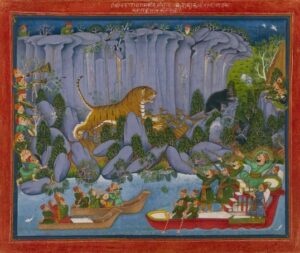
- A style of painting very much akin to the Bundi style also prevailed in Kotah a place near Bundi, during the late 18th and 19th centuries.
- Themes of tiger and bear hunt were very popular at Kotah. In Kotah paintings, most of the space is occupied by the hilly jungle which has been rendered with a unique charm.
Amber – Jaipur:

- The State of Amber had the closest relations with the Mughal Emperors. It is generally believed that a school of painting originated at Amber, the old capital of the Amber State, in early 17th century. Later on in the 18th century, the centre of artistic activity shifted to Jaipur, the new capital. There is a fairly large number of portraits of the Jaipur rulers and miniatures on other subjects which can definitely be assigned to the Jaipur School.
Marwar: 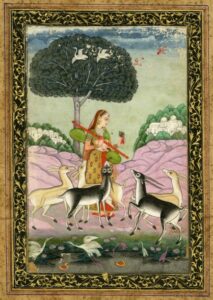
- One of the earliest examples of painting in Marwar is a series of the Ragamala in the collection of Kumar Sangram Singh, painted by an artist named Virji in 1623 A.D. at Pali in Marwar. The miniatures are executed in a primitive and vigorous folk style and are completely uninfluenced by the Mughal style. .
- A large number of miniatures comprising portraits, court scenes, series of the Ragamala and the Baramasa, etc. were executed from the 17th to 19th centuries at several centres of painting like Pali, Jodhpur and Nagour etc. in Marwar.
Bikaner:
- Bikaner was one of the States which had close relations with the Mughals. Some of the Mughal artists during the later half of the 17th century were given patronage by the Bikaner court and were responsible for the introduction of a new style of painting having much similarity with the Mughal and the Deccani styles.
- One important artist Ali Raza “the Ustad (master) of Delhi”, was employed by Raja Karan Singh of Bikaner in about 1650 A.D. Some other noteworthy artists who worked at the Bikaner court were Ruknuddin and his son Shahadin.
Kishenghar:
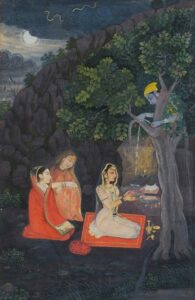
- During the second quarter of the 18th century, there developed the most charming school of Rajasthani painting in Kishengarh under the patronage of Raja Savant Singh (1748-1757 A.D.) who wrote devotional poetry in praise of Krishna, under the assumed name of Nagari Das. Unfortunately only a small number of Kishengarh miniatures are available.
- Most of them are believed to have been done by the master painter Nihal Chand who, in his works, has been able to create visual images of his master’s lyrical compositions. The artist has executed types of human figures, delicately drawn, with slender bodies and uptilted eyes.
The Pahari Schools (17th To 19th Centuries)
- The Pahari region comprises the present State of Himachal Pradesh, some adjoining areas of the Punjab, the area of Jammu in the Jammu and Kashmir State and Garhwal in Uttar Pradesh. The whole of this area was divided into small States ruled by the Rajput princes and were often engaged in welfare. These States were centres of great artistic activity from the latter half of the 17th to nearly the middle of the 19th century.
Basohli:
- The earliest centre of painting in the Pahari region was Basohli where under the patronage of Raja Kripal Pal, an artist named Devidasa executed miniatures in the form of the Rasamanjari illustrations in 1694 A.D.
- There is one more series of the Rasamanjari miniatures painted in the same style and almost of the same period but appears to be in a different hand.
- The Basohli style of painting is characterised by vigorous and bold line and strong glowing colours. The Basohli style spread to the various neighbouring states and continued till the middle of the 18th century.
- An illustration from a series of Gita Govinda painted by artist Manaku in 1730 A.D. shows further development of the Basohli style. The miniature which is in the collection of the National Museum, depicts Krishna in the company of gopis in a grove on the bank of a river.
- There is a change in the facial type which becomes a little heavier and also in the tree forms which assume a somewhat naturalistic character, which may be due to the influence of the Mughal painting.
- Otherwise, the general features of the Basohli style like the use of strong and contrasting colours, monochrome background, large eyes, bold drawing, use of beetles wings for showing diamonds in ornaments, narrow sky and the red border are observable in this miniature also.
Guler: 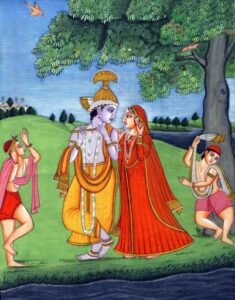
- The last phase of the Basohli style was closely followed by the Jammu group of paintings mainly consisting of portraits of Raja Balwant Singh of Jasrota (a small place near Jammu) by Nainsukh, an artist who originally belonged to Guler but had settled at Jasrota. These paintings are in a new naturalistic and delicate style marking a change from the earlier traditions of the Basohli art.
- The colours used are soft and cool. The style appears to have been inspired by the naturalistic style of the Mughal painting of the Muhammad Shah period.
- At Guler, another State in the Pahari region, a number of portraits of Raja Goverdhan Chand of Guler were executed in circa 1750 A.D. in a style having close affinity with the portraits of Balwant Singh of Jasrota. They are drawn delicately and have a bright and rich palette.
- The finest group of miniatures done in the Pahari region is represented by the famous series of the Bhagavata, the Gita Govinda, the Bihari Satasai, the Baramasa and the Ragamala, painted in 1760-70 A.D.
- The exact place of origin of these series of painting is not known. They might have been painted either at Guler or Kangra or any other nearby centre. The Guler portraits together with the Bhagavata and the other series have been grouped under a common title of “Guler Style” on the basis of the style of the Guler portraits.
- The style of these paintings is naturalistic, delicate and lyrical. The female type in these paintings is particularly delicate with well-modelled faces, small and slightly upturned nose and the hair done minutely. It is very likely that these paintings are in the hand of the master-artist Nainsukh himself or by one of his competent associates.
Kangra: 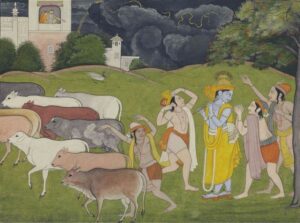
- The Guler style was followed by another style of painting termed as the “Kangra style”, representing the third phase of the Pahari painting in the last quarter of the 18th century.
- The Kangra style developed out of the Guler style. It possesses the main characteristics of the latter style, like the delicacy of drawing and quality of naturalism.
- The name Kangra style is given to this group of painting for the reason that they are identical in style to the portraits of Raja Sansar Chand of Kangra.
- In these paintings, the faces of women in profile have the nose almost in line with the forehead, the eyes are long and narrow and the chin is sharp. There is, however, no modelling of figures and hair is treated as a flat mass. The Kangra style continued to flourish at various places namely Kangra, GuIer, Basohli, Chamba, Jammu, Nurpur and Garhwal etc. Paintings of the Kangra style are attributed mainly to the Nainsukh family. Some of the Pahari painters found patronage in the Punjab under Maharaja Ranjit Singh and the Sikh nobility in the beginning of the 19th century and executed portraits and other miniatures in a modified version of the Kangra style which continued till the middle of the 19th century.
Kulu – Mandi:

- Along with the naturalistic Kangra style in the Pahari region, there also flourished a folk style of painting in the Kulu-Mandi area, mainly inspired by the local tradition.
- The style is marked by bold drawing and the use of dark and dull colours. Though influence of the Kangra style is observed in certain cases yet the style maintains its distinct folkish character. A large number of portraits of the Kulu and Mandi rulers and miniatures on other themes are available in this style.
Orissa:
- The earliest surviving examples of miniature painting in Orissa appear to belong to the 17th century A.D.
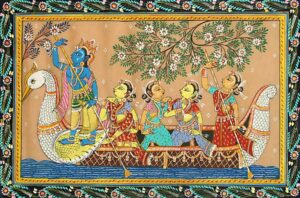
- An illustrated palm-leaf manuscript of the Bhagavata in the Asutosh Museum and a paper manuscript of the Gita Govinda in the National Museum are examples of the 18th century Orissa painting.
- In Orissa, palm-leaf continued to be used even upto the 19th century. The outline drawing was rendered with a stylus on the palm-leaf and then charcoal or ink was rubbed on the drawing.
- A few colours were sparingly used to fill in the designs. The technique of painting on paper was, however, different and was like the one used in other schools of painting. The early manuscripts display a neatness in drawing.
- Later on in the 18th century the line becomes bold and a little crude but the style in general is very decorative and ornamental.
Technique:
- Paintings were executed in the traditional tempera technique. After mixing colours in water along with a binding medium they were applied on the drawing.
- First, the sketch was freely drawn in red or black over which a white priming was given. The surface was thoroughly burnished till the outline showed clearly through it. Then a second outline was drawn with a fine brush.
- First the background was coloured and then the sky, buildings and trees, etc. Figures were painted last of all after which a final outline was drawn. When copies were made from perforated sketches by rubbing- charcoal powder, the dotted outline took the place of the first drawing.
- Colours used in paintings were obtained from minerals and ochres. Indigo was the vegetable colour. Lac-dye and red carmine were obtained from insects. Burnt conch shell and zinc white(safeda) were used as white colour.
- Lamp black and burnt ivory (Kajal) were used as black colour. Red ochre (geru), red lead (sindhura), lac-dye and red carmine were used as red colour, indigo and ultramarine were used for blue. Yellow ochre, orpiment and peori (extracted from urine of cows fed on mango-leaves) were used for yellow. Silver and gold were also used.
- Terraverte, malachite and verdigriz (Zangal) were used as green colour which was also obtained by mixing other colours. Gum arabic and neem gum were used as binding media in colours. Brushes were made of animal’s hair. Fine brushes were made from squirrel’s hair, the finest being of a single hair. Apart from palm leaf and paper, wood and cloth were also often used as materials for painting.
- The traditional Indian painting started deteriorating after the first half of the 18th century and by the end of the century it lost most of its vitality and charm. However, in the Pahari region the art of painting maintained its quality till the end of the first quarter of the 19th century. Under the impact of the Western colours and technique of painting the traditional styles of Indian painting finally died out in the second half of the 19th century.

